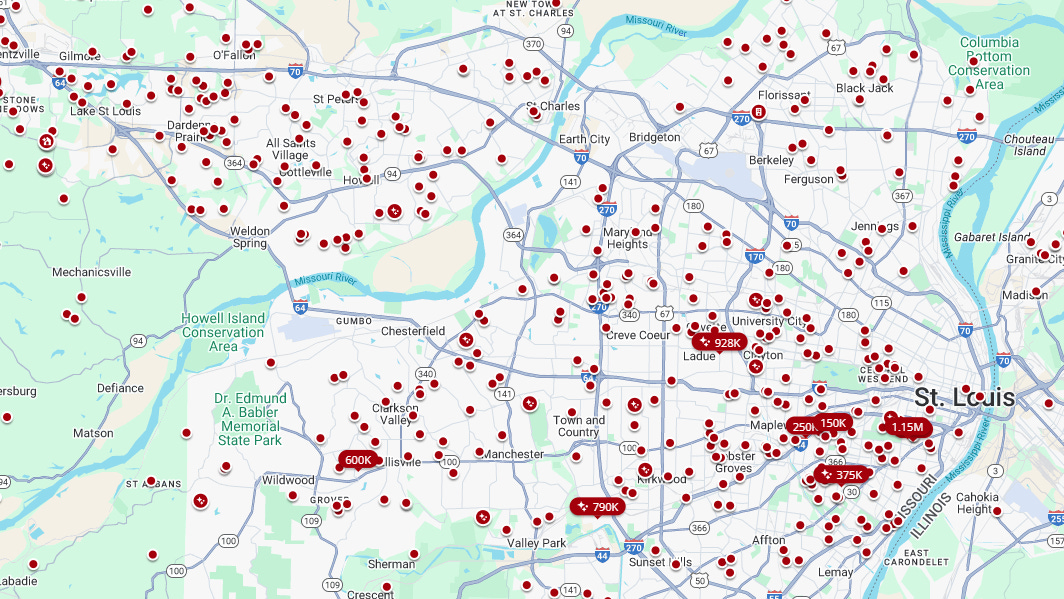People really like buying single family homes.
Most of the red dots in the screenshot I just took from Zillow are almost certainly detached, single family homes. That’s not super unique to St. Louis, either. If we took a look at any cities further west, it gets even more tilted in that direction.

As an urbanist, my gut reaction is that I don’t like that. There are a few negative things that immediately come to mind:
Sprawl
Negative environmental externalities
Infrastructure costs
Actual housing costs
Roots in segregation and racialized zoning practices
So if you asked me,
“Brian, ahem - Dr. YIMBY Manifesto, do you like what you see here?”
The answer is a resounding, “no.”
But it is a bit more complicated than that. It’s annoying to keep on saying this, but most things have a lot of nuance. While a lot of the suburban sprawl plaguing our cities is bad (depending on the metrics we choose), there are some things we should probably take note of if we want to grow our cities and not just our suburbs.

So why are people buying these single family homes? There are a few reasons:
Cost - even though they’re expensive, it’s cheaper oftentimes to buy a large McMansion than it is to rehabilitate a 120-year old brick home. I’m speaking from experience here, and probably more mold and asbestos than I’d like to have inhaled.
Space - if you’re starting a family, whether justified or not, you typically want more space. I covered how we can respond to this the other day (give it a read!), but it’s a tangible incentive we have to deal with.
Zoning - it’s the housing that gets built because in so many places it is the only housing that legally can be built.
Schools - areas with good schools typically have suburban characteristics and suburban homes.
Perception of “The American Dream” - does your family think that you’ve succeeded if you’re living in a one-bedroom apartment? These are real social pressures we all face, fight, and ferment.
So, if people want single family homes - or at least think that they should - we’re going to keep on sprawling until we figure out how to harness this demand in our urban cores.
Note, I do not think we should be advocating for McMansions in our downtowns or anywhere close. But, as a true YIMBY, I suppose if you wanted to build one, then don’t let me stop you.
Instead, I think we should make it as easy as possible to build denser forms of family style homes. Earlier this week, I advocated for all sorts of different ways we could do that.
But, today, I want to focus on single family homes in particular. How can we do that?
Truth be told, we already have. We owned a 640 square foot single story home in St. Louis with 640 square feet of additional living space in the basement. It was a super cute home, and we admittedly lost more money than I’d like to admit fixing everything that went wrong (and let me tell you, everything went wrong).
This kind of housing stock used to be normal. We’re talking single family homes with multiple bedrooms and bathrooms that are barely a few feet apart, have small yards and setbacks, and are nearly as dense as townhomes. Are these the perfect urban form? Probably not, but they’re way more efficient than the typical type of suburban single family home that we usually build.
Moreover, they’re cheaper to furnish, heat, cool, and build.
This is the kind of single family home that is compatible with urban interests - among others. Together with other mixed forms of housing, we can create walkable neighborhoods with enough density and character to make them both interesting and livable.
When we talk about building better, more accessible cities for all, let’s keep our eyes open. I advocate for “The Everything Approach to Housing”, of which dense, small single family homes absolutely can be a major part of.
I want as much density as possible, but if we’re going to bring people back to cities, let’s build homes that are compatible with their lives and our urban goals.




